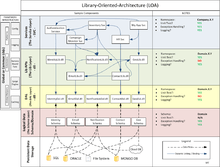Library Oriented Architecture

In software engineering, a Library Oriented Architecture (LOA) is a set of principles and methodologies for designing and developing software in the form of reusable software libraries constrained in a specific ontology domain. LOA provides one of the many alternate methodologies that enable the further exposure of software through a service-oriented architecture. Library orientation dictates the ontological boundaries of a library that exposes business functionality through a set of public APIs. Library Oriented Architecture further promotes practices similar to Modular Programming, and encourages the maintenance of internal libraries and modules with independent internal open-source life-cycles. This approach promotes good software engineering principles and patterns such as separation of concerns and designing to interfaces as opposed to implementations.
Principles
Three principles rule Library Oriented Architecture frameworks:
- A software library implementation and subject area expertise must be constrained to only one ontology domain.
- A software library that needs to use concepts and artifacts from a different ontology domain than the one it belongs to, must interface and reuse the library corresponding to that specific ontology domain.[1]
- All domain specific software libraries must be maintained and supported with separate life-cycles.[2]
Benefits
Library Oriented Architecture may provide different process improvements to existing software engineering practices and software development life-cycle. Some tangible benefits from its adoption are:
- Simplify configuration management of distributed systems.[3]
- Build highly reliable software systems because of the inherent properties and constraints of the LOA principles.
- Information Systems built using LOA are technology-independent. These systems can easily replace or swap entire libraries and domain implementations with localized impact and minimal upstream ripple effect.
- Increase the Maintainability Index[4] of your distributed systems and integration repositories.
- Minimize the risk of high coupling, this can be more evident on large enterprise systems.
- Bring developers up to speed orders of magnitude more quickly than a traditional system. Move developers and teams across libraries and domain ontologies and collaborate seamlessly.
- Spot bugs and zero-in on the problem almost instantly. There is something to be said about the amount of time a developer spends debugging.
- Maximization of the Bus Factor of the software engineering team.[5]
See also
- Ontology in Information Science
- Service-oriented architecture
- Distributed System
- Modular Programming
- Software Library
- Software Design Patterns
- Writing Elegant Code and the Maintainability Index
- Code Metrics - Maintainability Index
References
- ↑ Gruber, Thomas Robert (1992). "Toward Principles for the Design of Ontologies Used for Knowledge Sharing" (PDF). International Journal Human-Computer Studies. 43: 907–928.
- ↑ Triana, Michel. "Library Oriented Architecture". Retrieved 2012-04-09.
- ↑ Crowley, Richard. "Developing Operability". Retrieved 2012-04-09.
- ↑ Triana, Michel. "Writing Elegant Code and the Maintainability Index". Light of Bytes. WordPress. Retrieved 2012-04-12.
- ↑ Redmond, Matthew C.; Paul Newton (2003). "Integrating GIS in the Engineering, Planning and Design Processes" (PDF). Retrieved 2012-04-12.